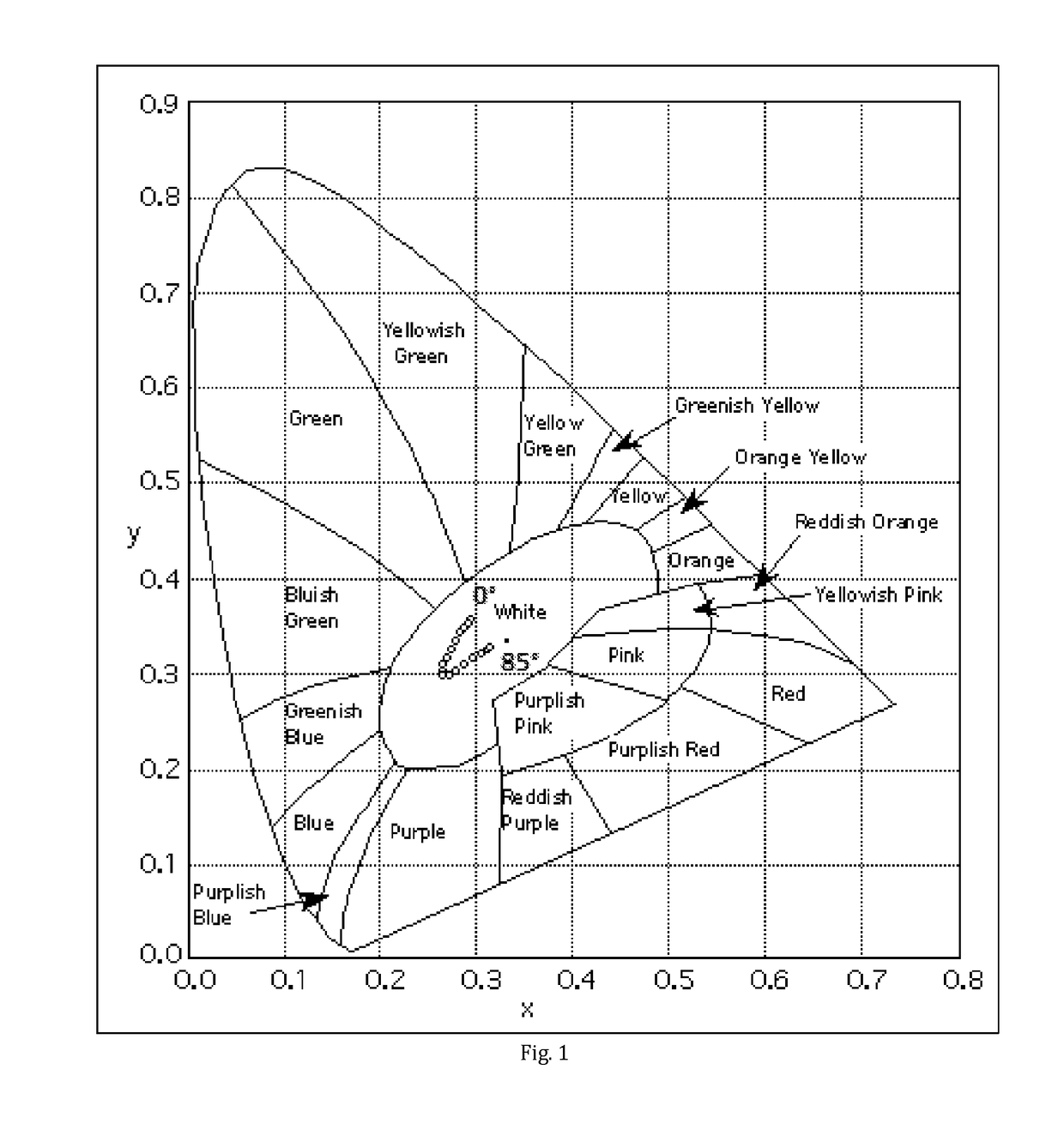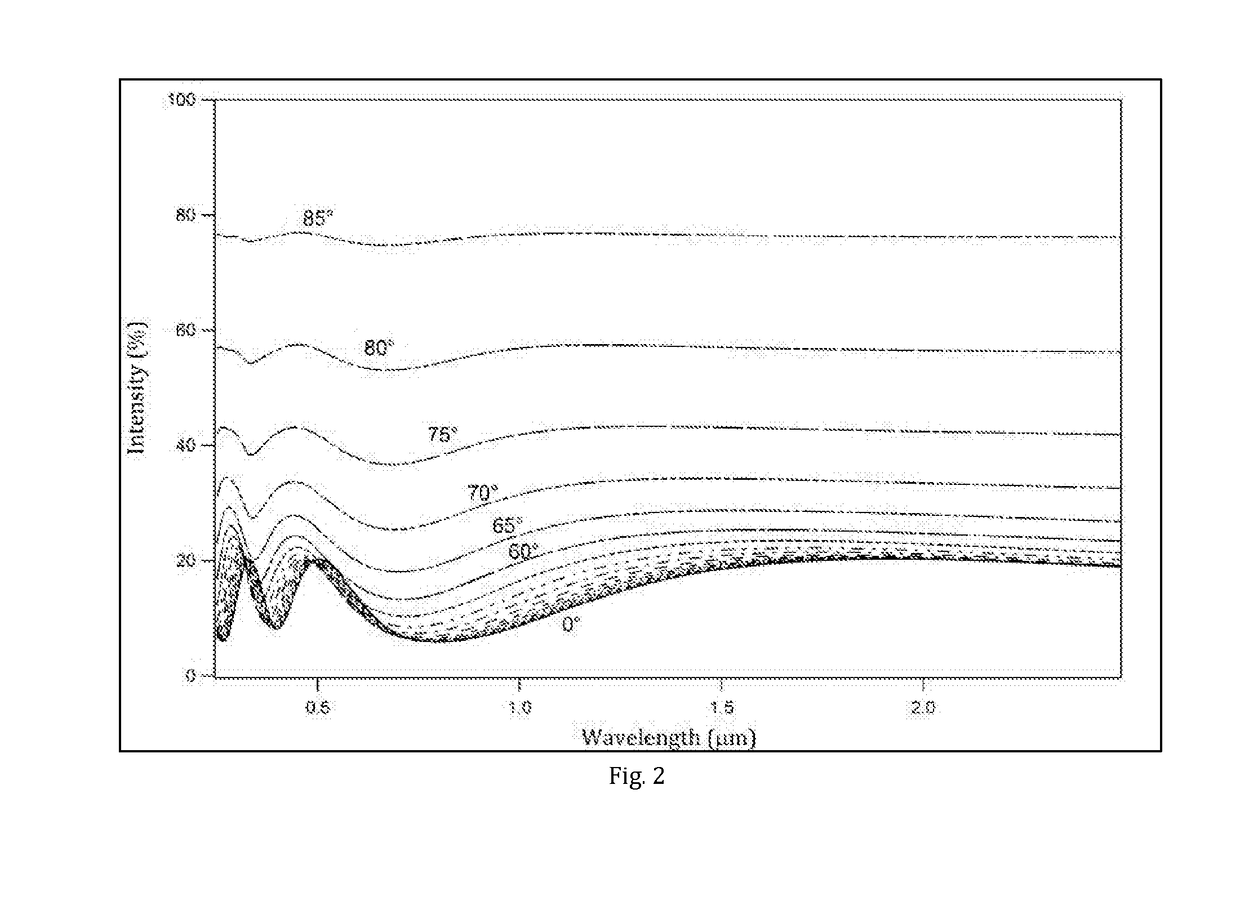Laminated glazing with coloured reflection and high solar transmittance suitable for solar energy systems
a technology of solar energy system and laminated glazing, which is applied in the field of laminated glazing with coloured reflection and high solar transmittance suitable for solar energy systems, can solve the problems of limiting the possibilities of solar roll glass, extra-white float glass (very low iron-content) or polymeric materials, and the surface flatness is also critical, so as to improve the flatness, strengthen the masking effect of the coloured filter, and the effect of improving the flatness
Active Publication Date: 2019-03-14
KROMATIX SA
View PDF0 Cites 4 Cited by
- Summary
- Abstract
- Description
- Claims
- Application Information
AI Technical Summary
Benefits of technology
The present invention provides a solar glazing unit with enhanced masking effect, angular colour stability, and mechanical stability. The coloured laminated glazing system is made of glass and has high solar transmittance, low refractive indices, and good adhesion to glass or polymer panes. The system has a masking effect that reinforces the colored filter and prevents glare effects. The glass panes and other elements are joined together by lamination using polymers that meet security requirements for facade applications. The lamination offers the possibility for different supply chains for coating and etching, and the coloured coating is encapsulated, avoiding any color change due to water condensation on the inner side of the glazing when mounted on thermal collectors. The laminated glazing offers good mechanical strength and is suitable for use in solar applications.
Problems solved by technology
In order to ensure a maximal efficiency of the solar energy system, the substrate has to present a high solar transmittance, thus limiting the possibilities to solar roll glass, extra-white float glass (very low iron-content) or polymeric materials such as polyethylene terephthalate (PET), polyethylene naphtalate (PEN), fluorocarbon polymer (PFA, FEP, ETFE, PTFE .
The surface flatness is also a critical issue, especially for facade applications.
Method used
the structure of the environmentally friendly knitted fabric provided by the present invention; figure 2 Flow chart of the yarn wrapping machine for environmentally friendly knitted fabrics and storage devices; image 3 Is the parameter map of the yarn covering machine
View moreImage
Smart Image Click on the blue labels to locate them in the text.
Smart ImageViewing Examples
Examples
Experimental program
Comparison scheme
Effect test
example 1
[0157]air / / 136 nm of L / 222 nm of H / / glass / / 222 nm of H / 136 nm of L / / air
[0158]with nH=1.54 and nL=1.8
example 2
[0159]air / / glass / / 30 nm of H / 25 nm of L / 320 nm of H / / polymer
[0160]with nH=2.4 and nL=1.65
example 3
[0161]air / / glass / / 185±12 nm of H / 25±12 nm of L / 35±12 nm of H / 35±12 nm of L / 130±12 nm of H / / polymer
[0162]with nH=2.4 and nL=2.0
the structure of the environmentally friendly knitted fabric provided by the present invention; figure 2 Flow chart of the yarn wrapping machine for environmentally friendly knitted fabrics and storage devices; image 3 Is the parameter map of the yarn covering machine
Login to View More PUM
| Property | Measurement | Unit |
|---|---|---|
| visible reflectance | aaaaa | aaaaa |
| total hemispherical solar transmittance | aaaaa | aaaaa |
| solar transmittance | aaaaa | aaaaa |
Login to View More
Abstract
A laminated and etched glazing unit having a substrate and a multi-layered interference filter each delimited by two main faces; the incident medium having a refractive index ninc=1, the substrate having a refractive index nsubstrate defined as: 1.45≤nsubstrate≤1.6 at 550 nm, and the exit medium being defined as follows 1.45≤nexit≤1.6 at 550 nm; and wherein the following requirements are met: The saturation of the colour is higher than 8 at near-normal angle of reflection, except for grey and brown; the visible reflectance is higher than 4%; the variation of the dominant wavelength MD of the dominant colour MD of the reflection is smaller than 15 nm for θr<60°; and the total hemispherical solar transmittance is above 80%.
Description
FIELD OF THE INVENTION[0001]The invention deals with coloured laminated glazing suitable for solar energy systems offering architectural integration of solar energy systems, e.g. as solar active glass facades.DEFINITIONS[0002]Direct Transmittance[0003]If parallel beams of radiation incident on a surface, an interface, or a specimen result in transmitted parallel beams, the transmittance is considered as direct. This is the case e.g., for flat surfaces or interfaces.[0004]Diffuse Transmittance[0005]If parallel beams of radiation incident on a surface, an interface, or a specimen result in a more or less wide angular distribution of transmitted beams, the transmittance is considered as diffuse. This is the case e.g., for rough surfaces or interfaces, or for specimens of granular structure. In general, the diffuse transmittance depends on the angle of incidence and the wavelength λ of the radiation. If the angle of incidence is not explicitly mentioned, commonly normal incidence is ass...
Claims
the structure of the environmentally friendly knitted fabric provided by the present invention; figure 2 Flow chart of the yarn wrapping machine for environmentally friendly knitted fabrics and storage devices; image 3 Is the parameter map of the yarn covering machine
Login to View More Application Information
Patent Timeline
 Login to View More
Login to View More Patent Type & Authority Applications(United States)
IPC IPC(8): H02S20/26B32B17/10H01L31/048B32B17/06B32B7/02H02S20/23
CPCY10T428/24942B32B17/10036Y02B10/12H01L31/0488B32B2457/00B32B2307/418B32B17/064B32B7/02H02S20/26H02S20/23Y10T428/24355B32B17/10146B32B17/10788B32B17/10761B32B17/10743B32B17/10201B32B17/10B32B2367/00Y02E10/40F24S80/52B32B17/1011Y02E10/50Y02B10/10B32B17/10005G02B5/281G02B5/286Y10T428/2495Y10T428/24967B32B17/06
Inventor HODY LE CAER, VIRGINIESCHULER, ANDREAS
Owner KROMATIX SA
Features
- R&D
- Intellectual Property
- Life Sciences
- Materials
- Tech Scout
Why Patsnap Eureka
- Unparalleled Data Quality
- Higher Quality Content
- 60% Fewer Hallucinations
Social media
Patsnap Eureka Blog
Learn More Browse by: Latest US Patents, China's latest patents, Technical Efficacy Thesaurus, Application Domain, Technology Topic, Popular Technical Reports.
© 2025 PatSnap. All rights reserved.Legal|Privacy policy|Modern Slavery Act Transparency Statement|Sitemap|About US| Contact US: help@patsnap.com



